By Barani Krishnan
Investing.com - Oil prices rose for a seventh-straight day and as New Year's Eve neared, on optimism about global travel in 2020 despite risks expected from Covid variants.
Saudi King Salman’s call on oil producers to stick with OPEC+’s output caps and recommendations to ensure market stability also supported crude prices on Thursday. The 23-nation oil producing alliance, led by Saudi Arabia and Russia, meets on Jan. 4 to confirm a 400,000 barrels-per-day increase in output for February if it deems market conditions appropriate.
West Texas Intermediate, the benchmark for U.S. crude, settled Thursday’s trade up 43 cents, or 0.6%, at $76.99 per barrel. WTI has risen more than 13% over the past seven sessions, after slumping to a three-week low of $66.04 on Dec. 20 on fears about a wave of Omicron infections reported that week. Year-to-date, the U.S. benchmark is up 58%.
London-traded Brent, the global benchmark for oil, settled up 9 cents, or 0.1%, at $79.32. Brent is up more than 11% from its Dec. 20 low of $72.87. Year-to-date, the global benchmark is up 53%.
U.S. health authorities, led by the Centers for Disease Control and Prevention, have assured Americans over the past week that Omicron was a less risky form of the coronavirus compared with the original Covid-19 strain or the Delta variant, especially for those who are vaccinated.
The average number of daily confirmed coronavirus cases in the United States hit a record high of 258,312 over the past seven days, figures compiled by Reuters showed on Wednesday. The report did not determine how many of those infected were unvaccinated. Separately, CDC data shows that more than 61% of the total U.S. population is fully vaccinated, and over 32% of fully vaccinated adults have received a booster.
The final weeks of December are typically strong periods for gasoline and diesel consumption in the United States as people take to the road for Christmas, New Year and holiday travels. Trucking activity is also heavy at this time of year due to seasonal gift deliveries.
Weekly oil inventory data from the Energy Information Administration on Wednesday reinforced those trends.
Crude inventories fell by 3.576 million barrels during the week ended Dec. 24, the EIA reported in its Weekly Petroleum Status Report.
Industry analysts tracked by Investing.com had anticipated a drawdown of just around 3.233 million barrels for the week.
The latest crude stockpile drop followed back-to-back declines of 4.715 million and 4.584 million barrels in two previous weeks that also exceeded expectations.
In an aberration to usual consumption, U.S. gasoline stockpiles swelled two weeks ago by their most in six months as fuel demand briefly slumped amid cutbacks to social activity triggered by Omicron concerns.
By last week though, gasoline usage was back to seasonal trends, with inventories falling by 1.459 million barrels, their most since early November. Analysts had forecast a gasoline consumption of 31,000 barrels for last week.
Distillates inventories also fell by a substantial 1.726 million barrels last week, the most in three weeks, versus expectations for a drawdown of 59,000 barrels.
